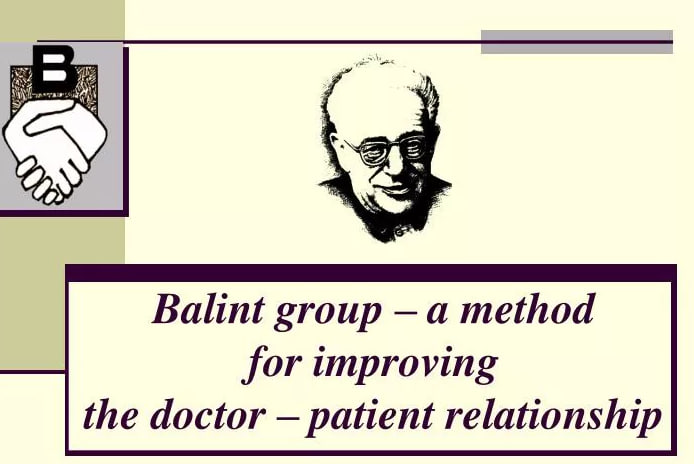
Michael Balint is a Hungarian-British psychiatrist, psychoanalyst and psychotherapist. Specialist in group psychotherapy and group psychoanalysis. Founder of the Balint groups.
This method of group training research work was named after its creator, who, since 1949, held discussion group seminars with practicing doctors and psychiatrists at the Tavistock Clinic in London. The experience summarized by Balint in his book “The Doctor, His Patient and His Illness” formed the basis for the method of conducting research and training seminars. The central object of study in the classical Balint group is the doctor-patient relationship. The patient transfers to the doctor certain attitudes, emotional and behavioral stereotypes that are similar to his attitude towards the objects of his real life (significant persons in his immediate environment). Analysis of these relationships makes it possible to more fully understand the patient in all the diversity of his connections and interactions with the real world, which helps to increase the effectiveness of therapy.
Balint saw the objectives of the seminar sessions in the analysis of relationships in medical professional practice, the development of diagnostics of relationships, comprehension of the true needs of the patient, and a deep understanding of the disease.
At the moment, Balint groups are an effective method of increasing professional communication skills of specialists in helping professions, reducing professional stress and “emotional burnout”, understanding the problems of the patient/client and the difficulties of communication with him, awareness of the therapeutic significance of interpersonal relationships and their boundaries, awareness of one’s own “blindness” spots.”
Balint group classes are conducted in several stages or “steps”.
The first “step” can be conventionally called “identifying the customer.” The lesson traditionally begins with the facilitator’s question: “Who would like to present for consideration their own case, a problem that creates a state of discomfort?”
The second “step” is the “customer’s” story about his difficult case from practice. The leader and group members listen carefully. Their observations can be very useful for subsequent analysis of the speaker’s communication difficulties.
The third “step” is for the “customer” to formulate questions for the group based on his own case. At this stage, the facilitator helps the “customer” formulate requests (questions and wishes) to the group, which contain a desire to receive new knowledge, feedback and (or) group support. It is advisable to write questions on the board or tablet, because… all group members refer to them constantly, maintaining the accuracy of their content.
The fourth “step” is the group asking questions to the participant who presented the case. All spontaneous reactions of the participants, their behavior and emotional manifestations are recorded by the presenter and can later be the object of dynamic analysis.
At this stage, the “customer” is often surprised to discover that for some reason he forgot or did not take into account very important aspects of his case. Many unconscious moments become clearer for him.
The fifth “step” is the final formulation by the “customer” of the issues that he would like to bring up for discussion. Sometimes the wording of questions is retained in its original form. More often, however, they undergo changes. Some of the previously posed questions may even lose their relevance for the “customer”, thanks to his awareness of a number of points at the previous stage.
Often an additional question taken by the “customer” is the question of what aspects in the proposed case he is not sufficiently aware of, from the point of view of the group.
The sixth “step” is the group’s responses to the “customer’s” requests and free discussion.
All participants in a circle answer the surveys assigned to them. Responses may reflect the feelings of group members: “In this case, I feel like…”.
No less important than certain judgments and feedback for the “customer” and other participants may be answers like: “I also had a similar situation, and I found a way out…”. The very fact that many group members offer an identical or similar vision of his situation is of great importance to him, but the group does not seek to impose anything, realizing that the speaker can block the acceptance of information.
Free associations are also encouraged at this stage. After any member of the group has spoken, the “customer” can ask him clarifying questions if anything remains unclear. It may be that in a Balint group one participant consciously or unconsciously identifies himself with the “customer” or his “partner” in the situation under discussion. The latter’s statements could be, for example, like this: “You know, I imagined myself in place… when you said something to him, reproducing the situation, and at the same time stuttered, I felt tense.” Such statements have special value for the psychotherapist presenting the case, and for other participants as well. In a well-functioning Balint group, individual remarks provoke the continuation of the discussion in the form of further circles or a free, but correctly managed discussion. This leads to a deeper understanding of the problems, creative collective development of the voiced points of view, unexpected angles of vision of the situation under discussion.
Feedback from the group leader to the “customer” is carried out at the seventh “step”. The facilitator summarizes the group’s answers, expresses his own vision of the situation presented for discussion, assumptions about the reasons for the difficulties encountered by the “customer,” etc. At the end of the work, the leader thanks the “customer” for providing the case and the courage to analyze it, and the group members for their support of the employee.
At the eighth “step” the “customer” gives information about his feelings. His statements may relate to his own emotional state and impressions of the group’s work. He can also provide feedback to specific participants containing his opinion on the effectiveness of their activities, thank them for their support, or express their condition in words. A Balint session may end with statements from individual group members about their feelings and impressions.
Leave a Reply